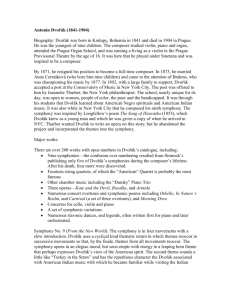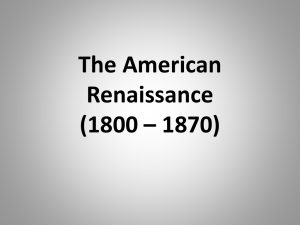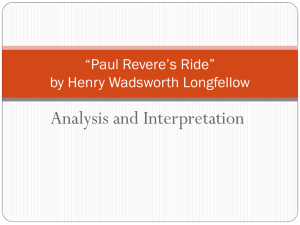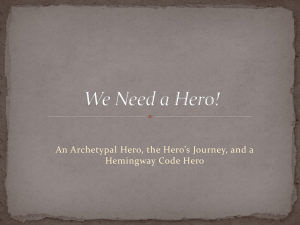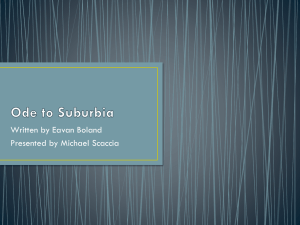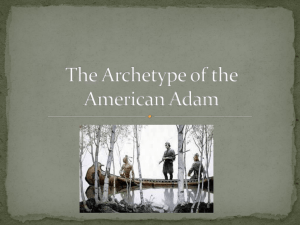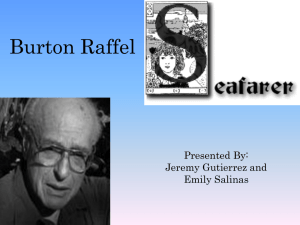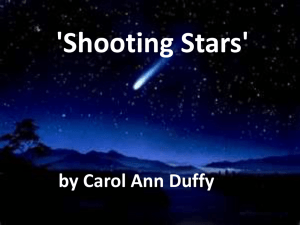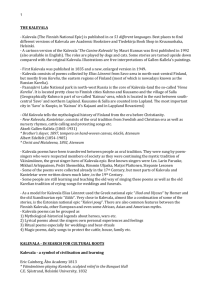Longfellow1useme - University Library System
advertisement
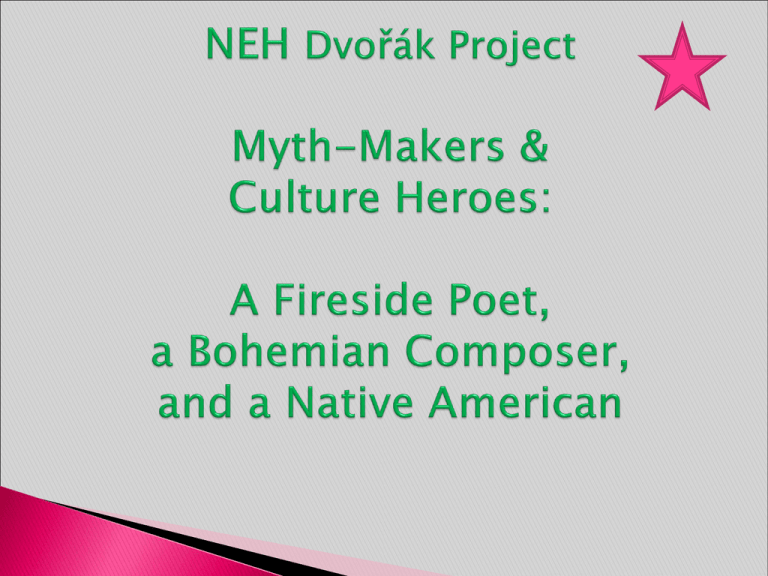
Myth [mith] noun 1. a traditional or legendary story, usually concerning some being or hero or event, with or without a determinable basis of fact or a natural explanation, esp. one that is concerned with deities or demigods and explains some practice, rite, or phenomenon of nature. Origin: 1820–30; < LL mȳthos < Gk mŷthos story, word What are some common myths? A culture hero is a mythological hero specific to some group (cultural, ethnic, racial, religious, etc.) who changes the world through invention or discovery. A typical culture hero might be credited as the discoverer of fire, or agriculture, songs, tradition and religion, and is usually the most important legendary figure of a people, sometimes as the founder of its ruling dynasty. The hero is sometimes said to be still living, but is often instead a star, constellation, animal, or purely spiritual in nature. A culture hero is generally not the person responsible for the creation but the one who completes the world and makes it fit for human life; in short, he creates culture. Do we have any CULTURE HEROES? Paul Bunyan Johnny Appleseed Until the third decade of the nineteenth century, America had little real literature to call its own. Fireside poets like Longfellow, Oliver Wendell Holmes, John Greenleaf Whittier, and William Cullen Bryant represented a literary coming-of-age for America. These popular poets’ works were widely read by the fireside in American homes for entertainment; and in the classroom where generations of Americans memorized them. The poems usually contained American settings and subjects. Henry Wadsworth Longfellow was a powerful figure in the cultural life of nineteenth century America. Born in 1807, he became a national literary figure by the 1850s and a worldfamous personality by the time of his death in 1882. One of Longfellow's writing technique is the backward glance. People in the present look back into their distant pasts and make a discovery. What had once been history — political, conflicted, sad, and bloody — could now be seen as imaginative myth: ordered, noble, and a source of strength. Longfellow wrote for a young nation ready to make this backward glance. This technique is a key to myth-making. Longfellow Longfellow wrote employed easy on obvious themes rhyme. with mass appeal. He wrote poetry His poems are with natural grace easily understood. and melody (bird). Above all, his tone Read or heard once has a spirit of or twice, his rhyme optimism and faith and meters are in the goodness of easily remembered. life. Longfellow was among the first of American writers to use native themes. He wrote about American scenes and landscapes, the American Indian (Song of Hiawatha), and American history and tradition (The Courtship of Miles Standish, Evangeline). Henry was born February 27, 1807, in Portland, Maine. Portland was a seaport, and this gave its citizens a breadth of view lacking in the more insular New England towns. The variety of people and the activity of the harbors intrigued the young man and gave him a curiosity about life beyond his own immediate experience. The book which influenced Longfellow the most was Washington Irving's Sketch Book. ◦ Irving was another American author for whom native legends and landscapes were sources of inspiration. "Every reader has his first book," wrote Longfellow later. "I mean to say, one book among all others which in early youth first fascinates his imagination, and at once excites and satisfies the desires of his mind. To me, the first book was the Sketch Book of Washington Irving." After graduating from Bowdoin College In May of 1826, he set out for Europe to turn himself into a scholar and a linguist. He stopped at small inns and cottages, talking to peasants, farmers, traders. He traveled in Spain, Italy, France, Germany, and England, and returned to America in 1829. At 22, he was launched into his career at Bowdoin as a modern European language professor. He had to prepare his own texts, at that time none were available. In 1834, he was appointed a professorship at Harvard and traveled to Europe again to prepare. This time with his young wife, Mary. The journey ended in tragedy. In Rotterdam, his wife died, and Longfellow returned alone. He took a room at the now historic Craigie House. \ Craigie House Seven years after he came to Cambridge, MA, Longfellow married Frances Appleton. Craigie House was given to Longfellow as a wedding gift. In 1854, he resigned from Harvard. With a great sense of freedom gave himself entirely to the task of his own poetic writing. In June of that year, he began The Song of Hiawatha. Who was Hiawatha? The historic figure lived among the Iroquois Nation. In the early 15th Century, about a hundred years before Columbus undertook his voyage, chaos and warfare reigned among the tribes. According to Iroquois oral tradition, Hiawatha was a solitary warrior: he lived in isolation until called by the earth’s creator (God) to promote peace among the tribes of the Iroquois. Hiawatha became the founder of the Five Nations of the Iroquois, from west to east across New York state – Seneca (People of the Great Hill), Cayuga (People of the Swamp), Onondaga (Keepers of the Fire), Oneida (People of the Standing Stone), and Mohawk (People of the Flint). His internal peacekeeping measures helped the Five Nations grow and prosper. In 1820’s Maine, Longfellow was exposed to a few local Native Americans. As a Harvard professor he talked with the young Ojibwa writer and preacher Kah-ge-ge-gah-bowh (also known as George Copway), who visited Boston in 1849. Native American languages fascinated Longfellow, his view was similar to many of his white contemporaries: the tribal peoples were a vanishing race soon to disappear or be absorbed into the dominant white society. As a keen student of national epics, he was determined to preserve “the ballads of a people” i.e. myth, before they became lost forever. The Song of Hiawatha was published on November 10, 1855, and was an immediate success. In 1857, Longfellow calculated that he had sold 50,000 copies of it. An 1890 edition featured illustrations by Frederic Remington, and continued the public’s love affair with the epic poem. Hiawatha is the hero—not the antagonist. Longfellow created poetical American mythology using the legend of Hiawatha. 1890 Book Cover by Fredric Remington Inside Illustration— Remington The Song of Hiawatha adapts its meter from a Finnish national epic Kalevala (call-e-vall-ah). The 22 cantos, or books, of Hiawatha’s song tell the story of the childhood and young adulthood of a god-like hero: strong enough to wrestle monsters and demons, gentle enough to woo and win the beautiful maiden Minnehaha. Her name, says the poet, means “Laughing Water.” As a background for the poem, Longfellow consulted Henry Rowe Schoolcraft's book on the Indian tribes of North America and perpetuated an error of Schoolcraft's that placed Hiawatha among the forest tribes of the northern Midwest as opposed to New York state. Despite its historical inaccuracies, Longfellow's poem inspired the public’s love for the natural beauty of the Minnesota forest that continues today. Raised by his grandmother, Nokomis, the young Hiawatha learns the ways of the world from forest animals, then teaches his own people to plant corn and establish a civilization. He also teaches them picture-writing, so that memory of their accomplishments will never fade. The final cantos of the poem take on a somber tone, that reflects the abolitionist Longfellow’s unease with the country’s growing conflict over slavery that would soon lead to the Civil War. Famine strikes Hiawatha’s people, Minnehaha dies, and soon the “Black Robes” (Catholic French Canadian priests) appear, marking the end of Hiawatha’s culture. The hero paddles his canoe into the sunset and disappears. The poem ends like Kalevala, where the old and wise central character (who represents paganism) makes way for a new king (Christianity). While The Song of Hiawatha was roundly praised on both sides of the Atlantic after its publication, criticism in more recent years has been considerably less favorable. Longfellow's choice to mimic the solemn, unrhymed meter of the Kalevala has caused his poem to be criticized by many, to the extent that some feel Longfellow plagiarized the Finnish work. However, the poem resonated with the public, regardless of any negative press. While the poem was sometimes mocked by his contemporaries, it has been subjected to increasing satire through the years, even being lampooned in Marx Brothers films and Bugs Bunny cartoons. Keep the idea of stereotypes in mind as you watch. Hiawatha’s Rabbit Hunt--1937 http://www.youtube.com/watch?v=UqqUslNoCFc The Logging-in of Hakawatha F.X. Reid, 1987 First, he sat and faced at the console Faced the glowing, humming console Typed his login at the keyboard Typed his password (fourteen letters) Waited till the system answered Waited long and cursed its slowness (Oh that irritating slowness Like a mollusk with lumbago) Waited for what seemed like hours Till the operating system Printed out the latest whinings From the man called superuser Moaning that some third year students Played adventure games at lunchtimes, Moaning that the Disc was nearly (Very nearly) full to bursting, Growling that he wouldn't take it Screaming that he'd get his own back By deleting peoples' disc files. 1841 – 1904 What does a Czech composer born in 1841 have to do with Longfellow’s Hiawatha? Dvořák composed his New World Symphony while he visited the United States during 1892-1895. Parts of the symphony are based upon Hiawatha, a poem that Dvořák read and appreciated in Czech in his native Bohemia. 1892—While in America, Dvorák takes an interest in the music of AfricanAmericans and American Indians. He urges American composers to compose in the spirit of the music they hear around them. What is “American Music” in your opinion? Do you think of Native Americans when you think of American music? Also in 1892, a wealthy American philanthropist, Jeannette Thurber, persuaded Dvořák to become director of a National Conservatory in New York that she (via her husband) was helping to finance. America was embarking on its own quest for a musical identity; ironically, Thurber and certain New York music critics had decided that Dvořák should create that identity for them. "He was a master chef who had cooked up Bohemian music," says Dvořák scholar Michael Beckerman. "Now they wanted him to cook up American music to a similar recipe." Dvorák was so taken with the poem that he even attempted (and abandoned) an opera of Hiawatha. Some critics believe Dvořák’s Hiawatha is influenced by Longfellow’s romanticized view, not genuine Indian culture. However, noted Dvořák expert Joseph Horowitz discusses "the 'Indianists' movement [Dvořák] helped to create," which produced "a huge repertoire of Indianist songs, sonatas, and even operas, many of which quoted actual Native American tunes.” Listen to the Largo from Dvořák’s New World Symphony: http://www.youtube.com/watch?v=2g8 p3JLSzsA&feature=related YouTube Dvorak - Symphony No. 9 "From the New World" - 2. Largo ½ Beckerman "finds in the Largo of the New World Symphony an elegy for the Native American, based on more or less explicit allusions to Longfellow's Hiawatha." “With a little sleight-of-hand, he turned to the American Indians for the equivalent of the Czech heroes and legends that he'd drawn on in his Bohemian works." (Beckerman). Does s music seem inspired by this chapter of Longfellow’s? How? Are there any specific chapters of Hiawatha that come to mind when you listened to the piece? What about the written clues? Now turn to chapter 16, Pau-Puk-Keewis. We are going to listen to a dramatic interpretation of that chapter as produced by Joseph Horowitz and Michael Beckerman. Beckerman explains, “The intense, vigorous [music] portrays the dance at Hiawatha's wedding of the magician Pau-PukKeewis, the hero's adversary and Antichrist figure; and the finale… matches Pau-Puk-Keewis's headlong flight from Hiawatha, who finally kills him. But most telling of all are the associations that fill the famous slow movement.” http://homepage.mac.com/bogdanoff/NW%20NY/Melo drama.mov What is your reaction to the dramatic interpretation of Hiawatha coupled with Dvořák’s music? Does it work? Are both the music and text enhanced by one another? Can you make a correlation with any popular music? What about rap with singing, i.e. B.o.b.’s Airplanes? “Several recent critics have suggested that Dvořák misunderstood American culture. Of course he did. So did everyone else. There can be no complete grasp of a culture, since the very idea of culture is always a combination of reality and illusion, a few hard facts and the myths that hold them together. Dvořák saw and heard what he did through a combination of his specific experiences in the United States and his predisposed preferences for certain kinds of themes and ideas, which he brought with him after decades of composing. But he certainly worked fervently to imagine what an American music might be.” Page 26-28 in Lit book, From the Iroquois Constitution by Dekanawidah (translated by Arthur C. Parker). Questions: How does IC explode common stereotypes about Native Americans? Why does the speaker use the imagery of the tree to expand his point? Based on this writing, is Longfellow’s Hiawatha a good reflection of a Native America? YouTube - WAR SONG. What is your reaction to the song? How is this music different from “American” music? Why do you think it is so different? 1. 2. Can Longfellow’s Hiawatha be seen as an example of American mythology? Defend or refute. Is the character of Hiawatha a culture hero? Defend or refute? 3. 4. Dvořák believed that Native American music was the future of American music. Thinking of this concept and Longfellow’s interest in Native Americans, why do you believe this group has been silenced? “There can be no complete grasp of a culture, since the very idea of culture is always a combination of reality and illusion, a few hard facts and the myths that hold them together.” Based on this lesson, do you agree with Beckerman? Why/why not? “There can be no complete grasp of a culture, since the very idea of culture is always a combination of reality and illusion, a few hard facts and the myths that hold them together.” Based on this lesson, do you agree with M. Beckerman? Why/why not? 4. According to critic Margaret Atrov, "Until recently ... the popular concept of Indian literature was shaped not by the Indian and even not by his translator, but by the white American writer. . . . There is no better way to correct the misrepresentations that have ingrained themselves in our folklore than to listen to the genuine voices of the Indian peoples. Since their poems are really songs meant to be chanted or sung as part of various rituals, it is indeed the voices of the Indians, ancient and authentic, despite the drawbacks of translation, that we hear when we read them.” Do you agree with Atrov’s idea of the authentic voice? (You may use music as an example .)
